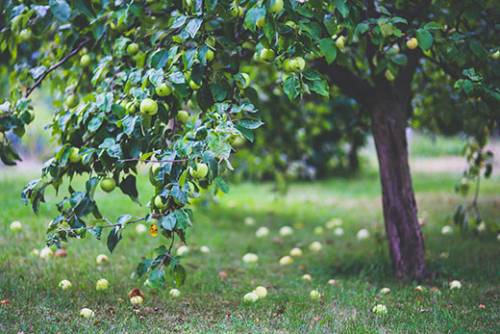Early Apple Drop

Nothing is more disappointing than watching your apples grow on the tree only to have them fall off unexpectedly just a few weeks away from ripening. An unexpected apple drop can be a serious concern for some varieties grown in Kansas. All apple cultivars have some fruit drop as they move through the ripening process. Some varieties are very prone to pre-harvest fruit drop.
As apples begin to ripen, they produce large amounts of ethylene, the ripening hormone. Ethylene stimulates softening of fruits and the formation of an abscission layer in the stem. Ethylene enhances the production of enzymes that break down the cell walls and the complex sugars that hold cell walls together in the abscission zone of the stem. As these glue-like substances break down, they leave the fruit connected only by the vascular strands, which are easily broken. Other stress factors might come into play with pre-harvest apple drop and can be related to the severity of drop from one year to the next. These include orchard and climatic factors such as fruit load, nutrition imbalance, summer pruning, insect or disease issues, and water and weather extremes during the growing season. Let’s look at some of the potential causes for early fruit drop in apples.
A large crop of a short-stemmed apple variety, particularly those set in clusters, will “push off” each other close to harvest. Good, early-season thinning, especially reducing clustered fruits, will help prevent this drop. When fruit is pushed off, it stimulates ethylene, which can cause an even more premature drop in the remaining fruits on the tree. Drop is often worse in orchards where soils have incorrect nutrient levels – in particular, low magnesium (Mg), high potassium (K), and high boron (B). Also, the variations in soil type can play a part; for instance, sandy areas will ripen early and drop ahead of heavier soil types.
Pre-harvest drop can be more severe in orchards that are heavily summer pruned. This problem is likely associated with a limitation or deficit of carbohydrate supply from too many leaves being removed, especially younger, more functional leaves. The drop will be increased if pruning reduces the leaf-to-fruit ratio below 20:1. When leaf-infecting insects are high in numbers, they can reduce the photosynthate produced by leaves. This limits carbohydrate availability and can lead to premature fruit drop. Pre-harvest drop is more severe in dry seasons, where irrigation is unavailable. Windy weather close to harvest also impacts fruit drop and can be worse in some varieties, especially those naturally prone to drop.
If you have issues with premature apple drop, you can pick them up early. Here are some recommendations to improve the quality:
- Store your fruit for a few weeks before using it.
-
- Many apples sold to grocery stores are stored for weeks or months before hitting the shelves. To ensure the apples can survive long-term storage, the orchards harvest them 1-2 weeks before peak ripeness.
- Apples are a “climacteric” fruit that ripens somewhat after picking. If you must pick early, try storing the fruit for a while to see if it becomes sweeter before use.
- Use the fruit in baked goods, sauce, or canned goods. These processes almost always call for added sugar that counterbalances the tartness of under-ripe fruit.
Alone, each of these factors can influence premature drop to some degree. However, when they occur in combinations, a severe drop can result. A few options to prevent apple drop for 2026 include proper nutrition, watering when the weather is dry, thinning your fruit early in the year, and pruning early in the spring.

Have questions? Contact our office where our Horticulture Extension Agent will assist you with questions.
Phone: (316) 321-9660
Email: callae@ksu.edu